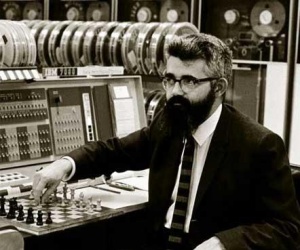Difference between revisions of "IBM 7090"
GerdIsenberg (talk | contribs) (Created page with "'''Home * Hardware * IBM 7090''' |border|right|thumb|300px| [[John McCarthy operating Kotok-McCarthy <ref>[http://www.computerhis...") |
GerdIsenberg (talk | contribs) |
||
| Line 1: | Line 1: | ||
'''[[Main Page|Home]] * [[Hardware]] * IBM 7090''' | '''[[Main Page|Home]] * [[Hardware]] * IBM 7090''' | ||
| − | [[File:JohnMcCarthy.jpg||border|right|thumb|300px| [[John McCarthy]] | + | [[File:JohnMcCarthy.jpg||border|right|thumb|300px| [[John McCarthy]] playing [[Kotok-McCarthy-Program|chess]] at IBM 7090, 1967 <ref>[http://www.computerhistory.org/chess/stl-431e1a07ca980/ John McCarthy, artificial intelligence pioneer, playing chess at Stanford's IBM 7090] | [http://www.computerhistory.org/chess/ Mastering the Game] | [[The Computer History Museum]] 1967 ca., Courtesy [[Stanford University]], [[John McCarthy]] used an improved version of the [[Kotok-McCarthy-Program|Kotok program]] to play correspondence chess against a [[TEP Chess Program|Soviet program]] developed at the Moscow [[Institute of Theoretical and Experimental Physics]] (ITEP) by [[Georgy Adelson-Velsky|George Adelson-Velsky]] and others. In 1967, a [[Stanford-ITEP Match|four-game match]] played over nine months was won 3-1 by the Soviet program.</ref> <ref>[http://infolab.stanford.edu/pub/voy/museum/pictures/display/1-1.htm CSD founding faculty] from [http://infolab.stanford.edu/pub/voy/museum/phototour.html Computer History Exhibits Photo Tour] created January 2000 by [http://infolab.stanford.edu/~gio/ Gio Wiederhold]</ref> ]] |
'''IBM 7090''',<br/> | '''IBM 7090''',<br/> | ||
Latest revision as of 10:14, 25 May 2018
IBM 7090,
an IBM mainframe computer of the 36-bit IBM 700/7000 series, and the first transistorized commercial computer [3] announced in 1958 and first installed in 1959 [4]. The basic instruction format was the same as the IBM 704 / IBM 709, 3-bit prefix, 15-bit decrement, 3-bit tag, and 15-bit address. The prefix field specified the class of instruction, the decrement field often contained an immediate operand, or was used to further define the instruction type. The tag bits specified any combination of three (7 for the IBM 7094) index registers, in which the contents of the registers were subtracted from the address to produce an effective address of an memory operand of a 32K words address space. More than 200 different instructions are provided, fixed-point arithmetic operations, floating-point arithmetic operations, logical operations, control and testing operations, input-output operations, shift operations, and numerous indexing operations [5], accumulator as implicit operand. 36-bit integer representation was ones'-complement, except for index registers which were two's-complement [6].
Chess Programs
See also
Selected Publications
- Alan Kotok (1962). A Chess Playing Program for the IBM 7090. B.S. Thesis, MIT, AI Project Memo 41, Computation Center, Cambridge MA. pdf
- James A. Saxon (1963). Programming the IBM 7090: A Self-Instructional Programmed Manual. Prentice-Hall, Inc.
- Gordon B. Davis (1965). An Introduction to the IBM 7090/94 Computer. McGraw-Hill, Inc.
External Links
- IBM 7090 from Wikipedia
- IBM Archives: 7090 Data Processing System
- The IBM 7090 from Columbia University
- The IBM 7094 from Columbia University
- IBM 7090/94 Architecture Home Page
- The IBM 7090 System and 7094 Systems
- From the IBM 704 to the IBM 7094 by John J. G. Savard
References
- ↑ John McCarthy, artificial intelligence pioneer, playing chess at Stanford's IBM 7090 | Mastering the Game | The Computer History Museum 1967 ca., Courtesy Stanford University, John McCarthy used an improved version of the Kotok program to play correspondence chess against a Soviet program developed at the Moscow Institute of Theoretical and Experimental Physics (ITEP) by George Adelson-Velsky and others. In 1967, a four-game match played over nine months was won 3-1 by the Soviet program.
- ↑ CSD founding faculty from Computer History Exhibits Photo Tour created January 2000 by Gio Wiederhold
- ↑ The IBM 7090 from Columbia University
- ↑ IBM 7090 from Wikipedia
- ↑ IBM Archives: 7090 Data Processing System (continued)
- ↑ IBM 7090/94 Architecture Home Page
